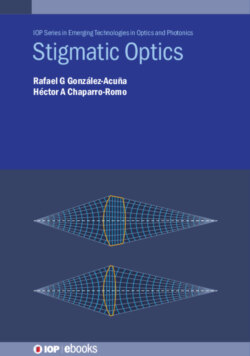Читать книгу Stigmatic Optics - Rafael G González-Acuña - Страница 22
На сайте Литреса книга снята с продажи.
1.11 Electromagnetic waves
ОглавлениеIt is time to find the solution of the wave equation of the electric field, we start by recalling equation (1.24),
∇2E⃗=μ0ε0∂2E⃗∂t2.(1.24)
The method that we are going to apply to solve it is called variable separation. The variable separation method refers to a procedure to find a particular complete solution for specific problems involving partial differential equations such as a series whose terms are the product of functions that have separate variables. It is one of the most productive methods in mathematical physics to find solutions to physical problems using partial differential equations.
Therefore, we are going to take the electric field as a function by the multiplication of a part that only depends on the position vector r⃗ and another function that solely depends on scalar time t.
E⃗(r⃗,t)=R⃗(r⃗)T(t)(1.31)
replacing equation (1.31) in the wave equation, equation (1.24),
∇2[R⃗(r⃗)T(t)]−μ0ε0∂2[R⃗(r⃗)T(t)]∂t2=0.(1.32)
Let us pause for a moment and set a simple notation to clear the procedure,
R⃗(r⃗)=R⃗,T(t)=T.(1.33)
Notice that ∇ only affects R⃗(r⃗) and ∂∂t only affects T(t), therefore equation (1.32) becomes,
∇2(R⃗)R⃗−μ0ε01T∂2T∂t2=0.(1.34)
Since terms are being differentiated by different independent variables, they must be equal to the same constant,
∇2(R⃗)R⃗=μ0ε01T∂2T∂t2=−k2.(1.35)
This leads us to a time-dependent differential equation given, by
∂2T∂t2+k2Tμ0ε0=0,(1.36)
where,
1c2=μ0ε0.(1.37)
The solution of equation (1.36) is given by,
T(t)=e−ikct.(1.38)
Therefore, we can write the electric field as,
E⃗(r⃗,t)=R⃗(r⃗)e−ikct(1.39)
where the spatial part of equation (1.39) is given by
∇2R⃗(r⃗)+k2R⃗(r⃗)=0.(1.40)
Equation (1.40) is the Helmholtz equation. The Helmholtz equation is a partial differential equation which is the spatial part of the wave equation.
Where k is the wave number defined as the number of radians per unit distance, we more often use
k=2πλ(1.41)
where λ is the wavelength. Thus, from the definition of the refraction index,
where w is the angular frequency. When light enters a medium, the wavelength is modified as,
λ=λcn(1.43)
where λc is the wavelength inside the medium. The wave number is also modified as,
k=kcn′(1.44)
where kc is the wave number inside the medium.
Recapitulating, we are working with a three-dimensional vector field such that,
E⃗(r⃗,t)=E⃗(x,y,z,t)=Ex(x,y,z,t)eˆx+Ey(x,y,z,t)eˆy+Ez(x,y,z,t)eˆz.(1.45)
Therefore, solving the Helmholtz equation is not the simplest task. It depends on the dimension of the wave, whether in one, two or three dimensions, and in the coordinate system. The coordinate system affects ∇; ∇ has different expressions for different coordinate systems. In the next subsection, we explore some particular solutions of the Helmholtz equation.
